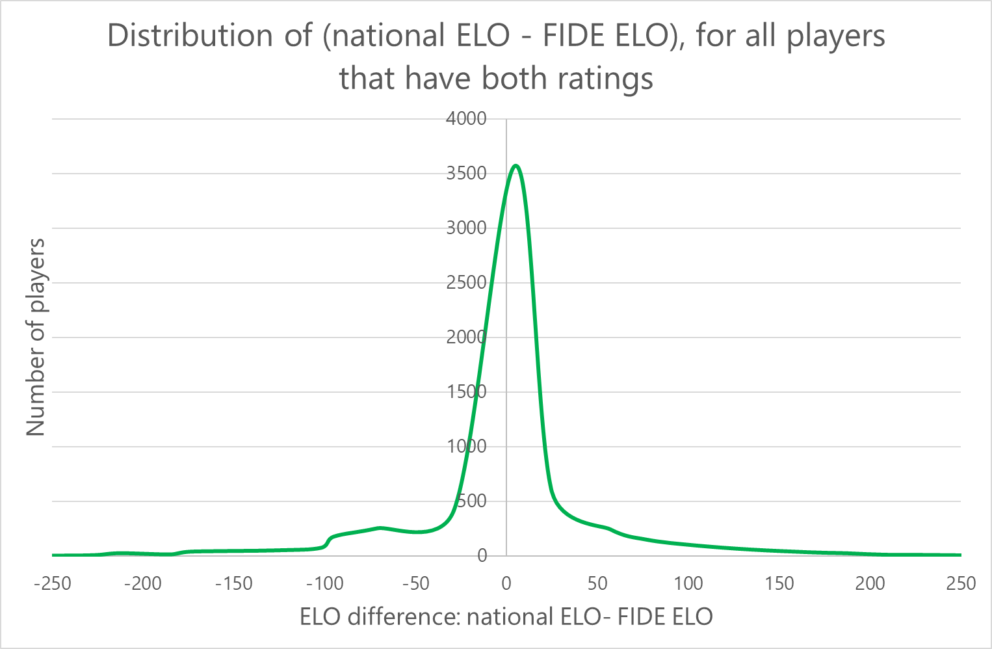This page explains the differences between the international FIDE rating system and our own national ELO calculation system. It also looks at our neighbouring countries, and summarizes information about their systems and way of working.
The national rating system is available here. The national rating system principle currently works as follows:
The FIDE rating system is available here. The first official FIDE rating lists in the early 1970’s included only players having a rating above 2200. This restriction stayed in place for twenty years, while the rating list grew twenty times bigger, from 600 players in the early 1970’s up to 12 000 players in the early 1990’s.
With the lowering of the minimum rating to 2000 Elo in January of 1993, FIDE began a new twenty-year phase of allowing progressively lower-rated players onto the rating lists.
The minimum was dropped again to 1800 Elo in October 2001 and then incrementally to 1600, 1400, 1200, 1000, until the current minimum of 1400 Elo was established in March 2024 after a one-time rating adjustment.
As the FIDE system becomes more mainstream, most active players have an active FIDE ID in the meantime:
In players_202401, 17 410 players have an ELO assigned, of which 1 995 players are rated at the minimum rating of 1 150 (11.4%). When selecting only active players, this ratio drops to 4%.
*players_period is the RBCF official database containing all player records for the given period.
The below graphs show the rating distribution based on the 2024-01 national rating list, and 2023-12 FIDE rating list. Note that, for the national rating system, players with a minimum rating of 1 150 are excluded.
The graphs below are generated before the one-time rating adjustment of FIDE March 1st 2024 and the subsequent national ELO rating changes April 1st 2024. Given there are some transient effects, we wil update the graphs accordingly in a couple of months.

6 116 players have both national ELO and FIDE ELO. When we compare their ratings, we arrive at a difference graph come below.

We can then also map the ELO differences on the national ELO categories. We notice that our national ELOs in the range [1150, 1550] tends to be lower then FIDE ELO. This can be explained by the fact that FIDE has a higher K-factor (40 vs 32) for new players (< 30 games), making them faster in tracking player progress. Our national ELOs in the range [1600, 2300] tend to be slightly above FIDE ELO. The average differences are all within an acceptable range of [-35, +20].

Here is a short summary of the most important differences between the national rating system and the FIDE rating system.
| National rating system | FIDE rating system | |
|---|---|---|
| Geographical | Belgium | World |
| Pool size *Active: played tournament last 12 months | ~ 6 000 active ~31 000 total | ~ 172 000 active ~ 436 000 total |
| Rating types | Standard | Standard, Rapid & Blitz |
| Minimum rating | 1400 | 1400 |
| Publication rate | 3 months | 1 month |
| # games 1st rating* | 5 | 5 |
| Max rating delta | 400 | 400 |
| K-factor | see section below | see section below |
| Cost | Included in KBSB membership | € 1 per player, per tournament |
| Process | Integrated in SWAR, submission after tournament | Announce in advance, Fixed templates, Strict deadlines |
The K-factor influences how quickly a player’s rating changes in response to their performance in games. A higher K-factor means ratings will change more rapidly, reflecting recent performance more heavily. Conversely, a lower K-factor results in more stable ratings, with less influence from individual game outcomes.
National ELO system K-factor
| Games played | ELO-rating | K-factor |
|---|---|---|
| ≤ 100 | 32 | |
| > 100 && ≤ 300 | 24 | |
| > 300 | ≤ 2000 | 16 |
| > 2000 && ≤ 2200 | 12 | |
| > 2200 | 10 |
FIDE rating system K-factor
| Games played | ELO-rating | K-factor |
|---|---|---|
| ≤ 30 | 40 | |
| >30 | < 2400 | 20 |
| ≥ 2400 (click) | 10 | |
| ≤ 18Y | < 2300 | 40 |
The Belgian Chess Player database keeps track of player information, including national ID number, FIDE ID number and national rating. By means of the FIDE database, it also links the player’s FIDE ID to its FIDE rating.
Whereas the national rating system and the FIDE rating system have their own administration and calculation, the FIDE rating system does impact the national rating system through various calculations:
The idea behind this rule is that foreign players play the majority of their games outside of Belgium, and hence their FIDE rating will be the more representative rating.
*Border players are foreign players that have requested the status of ‘border player’, meaning they testify they play the majority of their chess games in Belgium. Hence, we track their ELO rating in our own system, and do not synchronize with FIDE ELO.
This means that any change in the global rating level of FIDE, will impact (in the longer term) the national rating system as well.
What are our neighbouring countries doing? Are they also using their own national rating system? If so, why?
The table below lists the most neighboring European countries, together with the rating system and the tournament manager they are using.
| Country | Rating system |
|---|---|
| Netherlands | KNSB rating system (link) |
| France | FIDE |
| Germany | Own system, DWZ (link) |
| UK | ECF rating system (link) |
| Ireland | ICU ratings (link) |
| Denmark | Deense Schaakunie (link), with FIDE sync |
| Spain | FIDE since 2024, local systems keep existing |
| Portugal | FIDE (link) |
| Italy | Own system (link) |
| Sweden | FIDE (link) |
| Norway | FIDE (link) |
The Dutch Chess Federation uses a cloud solution for their national rating system. It requires tournament organizers to login online and announce their tournament in advance. Afterwards, tournament reports can be uploaded.
National rating system also processes games played by NL players abroad, by using the FIDE report file. This is the same as the current way of working of our own national rating system.
A general deflation of the ratings is visible in their rating system. It is compensated by giving a ‘bonus’ to youth players. A small difference in ratings between NL ratings and FIDE ratings is visible. Before, NL ratings used to be +/- 30 points less, nowadays they are +/- 20 points higher than FIDE.
Currently, two rating systems are in use: seniors and juniors. Motivation for seniors was before
Juniors currently have no FIDE alternative. The junior ratings can go really low (~ 100 ELO), and the ratings are rather dynamic to take into account the progress young players typically make in their first year(s). KNSB actually investigates the possibility to replace the youth rating system by the FIDE Rapid ratings. The increase of lower limit makes them reluctant to proceed with this thought.
The German Chess Federation is currently looking into ways to deal with the FIDE rating change, with respect to their own DWZ rating system. With the change, they will no longer be able to use the FIDE ELO when the player has no DWZ rating (because they are no longer comparable). FIDE rating in general right now is already ‘higher’ then DWZ rating. Also here, there are expectations that people will start questioning the use of the local DWZ rating system. Plans are there to ‘upgrade’ the DWZ system, so that it complies more with the FIDE ELO level, and this together with the development of a new software implementation.
Main arguments in Germany to keep a local rating system:
The FFE has abandoned its own national rating system for years already, and is now only using the FIDE rating system.
The Spanish Chess Federation, together with FIDE, converted their national rating system to the FIDE rating system as from January 1st, 2024. In Spain, several regions are still using their own, local rating systems that are still continuing as separate systems.
Main motivation to convert the national rating system to FIDE rating was the double work done for reporting. Only 2% of Spanish players did not have a FIDE ID. Most of the tournaments were reported twice: for the national rating, and for the FIDE rating. This was a waste of time and resources for them.
Do you have questions or remarks? Please get in touch with our national rating officer:
Steven Bellens
steven.bellens@frbe-kbsb-ksb.be

Steven Bellens 19.09.2024
October 1st, our national rankings get their 3-monthly update. In order for games to be processed, the tournament reports need to be submitted to ratings@frbe-kbsb-ksb.be at latest 27.09
Read more
Steven Bellens 13.09.2024
In our April survey, a majority of respondents indicated their preference of moving towards a unified global rating system (FIDE). In order to have a good understanding of both systems, we are launching this series of articles. This is the last of four articles explaining the arbiter requirements.
Read more
Steven Bellens 12.08.2024 12
In our April survey, a majority of respondents indicated their preference of moving towards a unified global rating system (FIDE). This is the second of four articles explaining the FIDE ELO cost structure.
Read more
Steven Bellens 24.08.2024 22
In our April survey, a majority of respondents indicated their preference of moving towards a unified global rating system (FIDE). In order to have a good understanding of both systems, we are launching this series of articles. This is the third of four articles explaining the reporting requirements for FIDE rated tournaments.
Read more